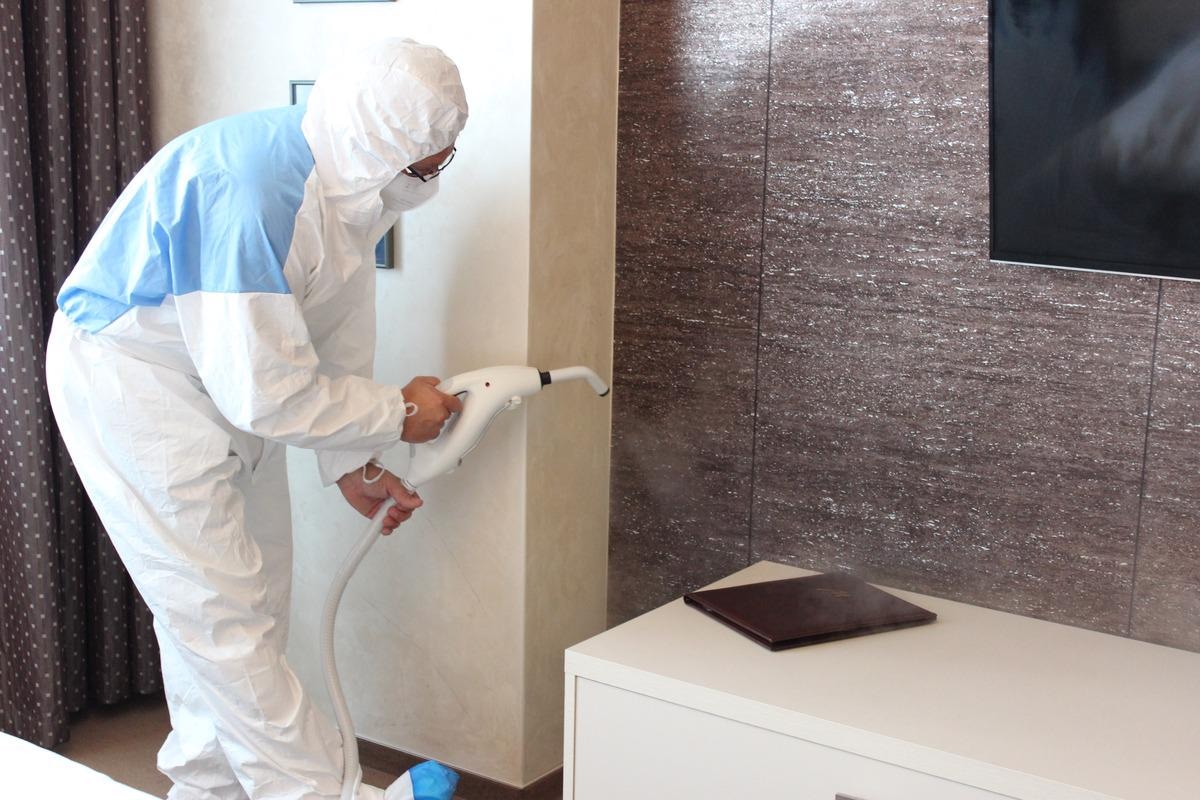
Severe acute respiratory syndrome coronavirus 2 (SARS-CoV-2), the causative agent of coronavirus disease 2019 (COVID-19), is transmitted through droplets or aerosols containing the virus and through virus-contaminated environmental surfaces.
 Study: Inactivation of SARS-CoV-2 and influenza A virus by spraying hypochlorous acid solution and hydrogen peroxide solution in the form of Dry Fog. Image Credit: Invisible Eye/Shutterstock
Study: Inactivation of SARS-CoV-2 and influenza A virus by spraying hypochlorous acid solution and hydrogen peroxide solution in the form of Dry Fog. Image Credit: Invisible Eye/Shutterstock
A new study investigates the use of aerosolized hypochlorous acid solution and hydrogen peroxide solution for inactivation of SARS-CoV-2 and influenza A virus adhering to an environmental surface. The solution was formulated as a Dry Fog that does not wet objects after contact. A preprint version of the study, which is yet to undergo peer review, is available on the bioRxiv* server.
SARS-CoV-2 and disinfection
In the current COVID-19 pandemic, the World Health Organization (WHO) recommends vaccination, avoiding closed and crowded places, social distancing, wearing a properly fitting mask, and frequently cleaning hands with an alcohol-based sanitizer or soap and water.
SARS-CoV-2 infects by inhaling droplets or aerosols containing the virus excreted from infected individuals or by touching the eyes, nose, or mouth with hands contaminated with the virus present on environmental surfaces. SARS-CoV-2 is highly stable on environmental surfaces. It is more stable than SARS-CoV and influenza A virus. Therefore, it is important to disinfect environmental surfaces to control the spread of the virus.
Frequent manual disinfection is impractical. An alternative would be spatial disinfection by spraying, but it is not recommended by WHO. Spraying disinfectants may be detrimental to the human body. The Centers for Disease Control and Prevention of the United States of America (USA) do not recommend spraying disinfectants in hospital rooms. Due to the lack of scientific validation, disinfectant spraying is not considered an adequate method for decontamination.
Dry Fog
Hypochlorous acid and hydrogen peroxide solutions leave negligible residue on environmental surfaces after spraying. This avoids the negative effects caused by residues on the human body. Dry Fog is diffusible and has a small droplet size. It is not necessary to wipe off the disinfectant after spraying. Dry Fog is assumed to fall at a low speed and float in the air for a long time. This also allows it to reach the backs of objects such as desks and chairs and hard-to-reach areas.
Hypochlorous acid solution is an aqueous solution that contains sodium hypochlorite in water. The pH of the solution is then adjusted to a weakly acidic pH of 6.5. The main component of the weakly acidic solution is hypochlorous acid (HOCl), while that of an alkaline solution is hypochlorite ions (OCl-). HOCl has stronger bactericidal effects than OCl-.
Different concentrations of hypochlorous acid solution with free available chlorine concentrations of 8,700, 250, and 125 ppm and hydrogen peroxide solution with concentrations of 56,400, 11,280, 5640, 2820, and 1410 ppm were made for this study.
Inactivation of SARS-CoV-2 and influenza A virus
SARS-CoV-2 and influenza A virus were added to 96-well flat-bottomed microplates and air-dried for the experiments. The plates were placed in a closed test chamber prepared to fill the space with Dry Fog.
Dry Fog spraying inactivated SARS-CoV-2 and influenza A virus in a time-dependent manner. The spraying of different concentrations of hypochlorous acid solution and hydrogen peroxide solution increased the exposed disinfectant amounts in proportion to the total spraying time and vice versa. After spraying the hypochlorous acid solution, the inactivation constant of SARS-CoV-2 was approximately 58-fold less than that of the influenza A virus.
After spraying the hydrogen peroxide solution, the inactivation constant of SARS-CoV-2 was approximately 9.6-fold less than that of the influenza A virus. Therefore, SARS-CoV-2 was more resistant to hypochlorous acid and hydrogen peroxide solutions than the influenza A virus. Furthermore, higher concentrations of spray solutions were required to inactivate SARS-CoV-2 than the influenza A virus.
Similar experiments were repeated with viral particles in artificial saliva. There were no significant differences in viral inactivation upon the spraying of disinfectants between dried viral samples prepared with artificial saliva or normal saline.
Significance
Further studies are required to investigate the effects of Dry Fog on the viral strains and viruses adhering to the surfaces of other materials.
This study provides important information for developing a strategy that would inactivate SARS-CoV-2 and influenza A virus on environmental surfaces. Spatial spraying of surfaces with Dry Fog containing hypochlorous acid solution or hydrogen peroxide solution can decontaminate surfaces in an unmanned space.
*Important notice
bioRxiv publishes preliminary scientific reports that are not peer-reviewed and, therefore, should not be regarded as conclusive, guide clinical practice/health-related behavior, or treated as established information.
-
Urushidani, M. et al. (2021) "Inactivation of SARS-CoV-2 and influenza A virus by spraying hypochlorous acid solution and hydrogen peroxide solution in the form of Dry Fog". bioRxiv. doi: 10.1101/2021.12.13.472413. https://www.biorxiv.org/content/10.1101/2021.12.13.472413v1
Posted in: Medical Science News | Medical Research News | Disease/Infection News
Tags: Alcohol, Coronavirus, Coronavirus Disease COVID-19, Decontamination, Disinfectant, Disinfection, Eye, Hospital, Hydrogen Peroxide, Influenza, Pandemic, pH, Respiratory, SARS, SARS-CoV-2, Severe Acute Respiratory, Severe Acute Respiratory Syndrome, Syndrome, Virus

Written by
Dr. Shital Sarah Ahaley
Dr. Shital Sarah Ahaley is a medical writer. She completed her Bachelor's and Master's degree in Microbiology at the University of Pune. She then completed her Ph.D. at the Indian Institute of Science, Bengaluru where she studied muscle development and muscle diseases. After her Ph.D., she worked at the Indian Institute of Science, Education, and Research, Pune as a post-doctoral fellow. She then acquired and executed an independent grant from the DBT-Wellcome Trust India Alliance as an Early Career Fellow. Her work focused on RNA binding proteins and Hedgehog signaling.
Source: Read Full Article